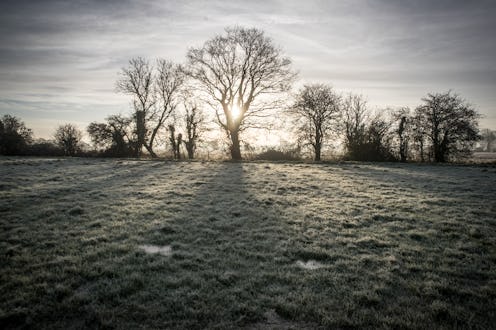Life
This Is What REALLY Happens To The Sun During The Winter Solstice

The winter solstice in the Northern Hemisphere is the shortest day of the year — and it's happening tomorrow, Dec. 21 (although the date could be different, depending on your time zone). In the U.S. and other parts of the hemisphere, the winter solstice also signifies the first official day of winter. Even though most of us know of the solstice, many are still unaware of what it means from a scientific standpoint. What does the sun do on the winter solstice? Let's explore.
The Sun During The Winter Solstice
We tend to acknowledge the entire day as the solstice; but in actuality, the solstice happens at one specific point: when the sun is exactly overhead the Tropic of Cancer. There are two solstices a year. During the summer solstice for the north, the sun is overhead the Tropic of Cancer in the Northern Hemisphere; but in December, it's overhead for the Southern Hemisphere. This helps explain why and how our solstices are opposite: tomorrow, the winter solstice for us will be the summer solstice for the Southern Hemisphere (specifically at 16:28 UTC). In other words, the sun reaches its southern-most position for those of us north of the equator. We are, quite literally, polar opposites.
The word "solstice" itself comes from the Latin solstitium, which means, "the sun stands still." The day is also referred to as the day the sun turns around. This is because when it reaches that point above the Tropic of Cancer, it seems to almost stand still before reversing direction, marking the point at which days start to get longer again.
Exactly How Short Will The Day Be?
The number of hours of sunlight you'll get depends on how far from the equator you are. The further north you are, the less sunlight you'll get. Here in Las Vegas, we can expect 9.5 to 10 hours of sunlight. If you live in Fairbanks, Alaska, however, you'll get under four hours. And if you happen to live north of the Arctic Circle, you'll get none. No sunlight for you!
Ironically, the shortest day of the year and the coldest day of the year are not one in the same, although it makes sense why we believe this. The coldest days of the year won't happen until January or February. The reason for this lag lies in the oceans: they absorb so much of the sun's energy that it gets released over time. In other words, the energy being released from the oceans keeps us warmer a little longer.
Because the exact timespan of a day has fluctuated over the years, the longest night we've ever seen was the 1912 winter solstice. But seeing as how Earth's days will continue getting longer (read the science behind it here), there will be many more opportunities in the future to have the "longest night ever."
The Truth About Our Distance From The Sun
A lot of us understandably think that during the winter solstice, the earth is farthest from the sun. The opposite is true: the sun is in closer proximity than ever. In fact, just a few weeks after the winter solstice, the earth will be on it Perihelion — the spot on its orbit where it's closet to the sun. This means that our seasons are not defined by the distance between the sun and earth, but rather the amount of sunlight reaching each hemisphere due to the tilt of the earth's axis. (Fun fact: we are tilted on an axis likely because billions of years ago, some massive objected collided into earth when it was still being formed.)
The winter solstice carries so much meaning behind it, aside from the behavior of the sun and earth. Some astrologers consider it the unluckiest day of the year.
People hold superstitions about the winter solstice and some believe it can even affect your mood. If you ask me (which I know you didn't, but I'm going to tell you anyway), the winter solstice is something to celebrate. Get ready to welcome more hours of sweet, sweet sunlight.